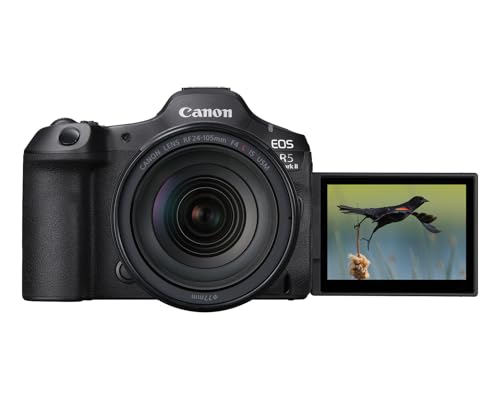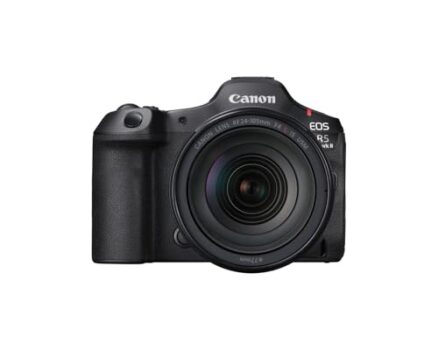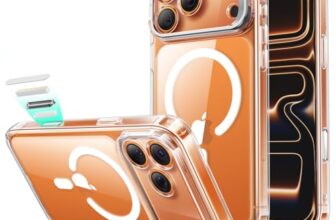Canon EOS R5 Mark II REVIEW: Ultimate Performance for Beauty Science Content
In the exacting world of beauty science reviews and high-fidelity tutorial creation, visual data is paramount. Your audience doesn’t just want to be *told* a product works; they demand to be *shown*. They crave pixel-level evidence of a serum’s absorption, a foundation’s texture, or the precise pigment dispersion in an eyeshadow. This level of content creation transcends typical vlogging and enters the realm of technical demonstration. For creators in this demanding niche, your camera isn’t just a tool; it’s your laboratory instrument. This is where the Canon EOS R5 Mark II with the RF24-105mm F4 L IS USM Lens enters the conversation, not merely as an upgrade, but as a potential paradigm shift for an entire genre.
The original EOS R5 was a landmark hybrid camera, but the Mark II iteration is a direct response to the needs of the most demanding solo creators and small production teams. It’s built around a trifecta of groundbreaking technologies: a completely new 45MP full-frame back-illuminated stacked CMOS sensor, a revolutionary AI-powered autofocus system featuring Eye Control, and the simultaneous capture of high-resolution stills and pristine 8K video. These aren’t just specifications on a data sheet; they are direct solutions to the most significant pain points faced by beauty and science-focused content producers. Imagine filming a 4K makeup tutorial while simultaneously capturing high-resolution 45MP images for your blog and Instagram, all without a single interruption. Imagine a camera that knows to focus on your eye when you speak to the lens, but *instantly* shifts focus to the product bottle the *moment* you look at it. This is the new reality the R5 Mark II proposes. This review will technically deconstruct each of this camera’s core features from the specific perspective of the beauty science reviewer and FAQ creator.

The 45MP BSI Stacked Sensor: A Revolution in Detail and Clarity
The heart of any camera is its sensor, and the R5 Mark II features a completely new, Canon-designed 45-megapixel full-frame powerhouse. But the “45MP” number is only the beginning of the story. The true innovation lies in its architecture: Back-Illuminated (BSI) and Stacked. Let’s break down why this technical combination is so critical for beauty and product analysis.
A Back-Illuminated (BSI) design fundamentally re-engineers the sensor’s circuitry. In traditional sensors, the wiring that transmits data sits *in front* of the light-sensitive photodiodes, partially blocking and reflecting incoming light. A BSI sensor moves this wiring *behind* the photodiodes. The practical result? Significantly more light reaches the sensor. For the beauty reviewer, this translates to two enormous advantages. First, you get dramatically improved low-light performance. You can film in softer, more flattering studio light with a lower ISO, resulting in a cleaner, noise-free image. This is the difference between skin that looks smooth and natural versus skin that looks “digital” and grainy. Second, this light-gathering efficiency improves dynamic range, allowing the camera to capture subtle detail in both the bright highlights of a liquid illuminator and the deep shadows of a contour, all in the same shot.
The Stacked part of the equation refers to speed. A stacked sensor integrates high-speed processing circuits and memory (DRAM) directly onto the sensor chip itself. This creates an information superhighway, allowing the sensor to be “read” at a staggeringly fast rate. This near-instantaneous readout speed is the key that unlocks almost all of the R5 Mark II’s other headline features. It’s what enables 30fps electronic shutter bursts, high-frame-rate 8K video, and, most importantly, a massive reduction in “rolling shutter” distortion. For video work, rolling shutter is the “jello” effect seen when panning quickly. When you pan across your product lineup or move your hand quickly to demonstrate a blending technique, a lesser sensor would warp the vertical lines. The R5 Mark II’s stacked sensor all but eliminates this, ensuring that your product bottles and brushes remain straight, true, and professional-looking, no matter how dynamic your camera movement is.
Finally, let’s address the 45-megapixel resolution. For a YouTube tutorial destined for a 1080p or 4K screen, 45MP might seem like overkill. It is not. This resolution is your “scientific” tool. It is the key to providing indisputable visual proof for your reviews. You can film a wide shot of your face, and in post-production, crop in 200%, 300%, or even 400% to show *exactly* how a new foundation is sitting within fine lines, or the micro-shimmer particle distribution in a highlighter. This ability to digitally “zoom” and reframe your 8K footage into multiple 4K or 1080p shots (a wide, a medium, a close-up) from a *single take* is perhaps the single greatest workflow enhancement for a solo creator. You no longer need to stop recording to change lenses or move the camera. You capture one flawless 8K take and create all your compositional variety in the edit. This resolution is your tool for “macro-like” detail, allowing you to fill the screen with the texture of a cream product or the precise application of a liquid eyeliner. For beauty science, this level of detail isn’t a luxury; it’s a necessity for credibility.

Unlocking Workflow Efficiency: Simultaneous Stills and 8K Video
The life of a hybrid creator—one who services a YouTube channel, a blog, and social media platforms—is one of constant, inefficient repetition. You film your video. Then, you break down your lighting setup to re-stage and re-shoot still photos for your thumbnail, your blog post, and your Instagram carousel. The Canon EOS R5 Mark II introduces a feature that fundamentally breaks this inefficient cycle: the ability to capture video and stills simultaneously, with no interruption. This is not a simple “frame grab” from a video, which often results in a low-quality, motion-blurred image. This is the camera capturing its full-resolution 45-megapixel still images *while* it is concurrently recording its high-bitrate 8K video.
Imagine your workflow: You are in the middle of a perfect, one-take application tutorial. You’re demonstrating a difficult “cut crease” technique. In the past, you’d have to pause, pick up a different camera (or change modes), and try to recreate the *exact* moment for a still photo. With the R5 Mark II, you simply press the shutter button. The camera silently captures a 45MP RAW file—perfect for editing in Lightroom or Photoshop—and your 8K video recording *never stops*. You get your hero thumbnail image, your blog’s “step-by-step” photos, and your primary video content all from one continuous performance. This feature alone can cut your production time in half. It keeps you in the creative flow and ensures your still photography has the exact same lighting, angle, and setup as your video, creating a powerful, cohesive brand identity across all your platforms.
This hybrid capability is intrinsically linked to the camera’s 8K video recording. As mentioned, the primary benefit of 8K for a beauty science reviewer is not 8K delivery; it’s 8K *acquisition*. By shooting in 8K, you are capturing an 8192 x 4320 pixel canvas. This gives you unparalleled freedom in post-production. You can digitally pan, tilt, and zoom. You can crop a single wide shot into a “three-camera” setup (wide, medium, and extreme close-up on the product) all in 4K. This ability to reframe is a game-changer for solo shooters. It makes your videos look more dynamic, more professional, and more engaging, as if you had a dedicated camera operator. Furthermore, this 8K-to-4K “oversampling” process produces a 4K image that is significantly sharper, cleaner, and more detailed than a video that was natively shot in 4K. It’s the ultimate “future-proof” format that provides tangible benefits *today*.
The Autofocus System That Reads Your Mind: Eye Control and AI Tracking
For a solo content creator, the autofocus system is your most important crew member. A missed-focus shot is an unusable shot. The R5 Mark II’s new autofocus system, powered by Canon’s next-generation Dual Pixel CMOS AF II and a deep-learning AI, is designed to be so reliable that you never have to think about it again. But it goes one step further with a feature that sounds like science fiction: Eye Control Focus.
First, the foundation: The AI tracking is more advanced than ever. It’s not just “Face/Eye Detect.” The camera has been trained to identify a human head and body, maintaining focus even when the subject (you) turns away from the camera. This is a common scenario in tutorials, where you might turn in profile to show a contour or look down at a palette. A lesser AF system would lose focus, but the R5 Mark II’s AI *knows* you are still the subject and holds focus on your head, snapping back to your eye the instant you turn forward. A new upgrade also allows the camera to maintain focus on a subject even when obscured briefly. Think about the most common action in a beauty review: holding a product up to the camera. You hold the bottle in front of your face, blocking it. On most cameras, the AF would immediately hunt, shifting focus to the bottle (which you want) but then getting “lost” and focusing on the background when you lower it. The R5 Mark II’s AI *remembers* your face. It will focus on the bottle, and the *instant* you lower it, it re-acquires your eye with zero hesitation or “focus breathing.” This one feature eliminates 90% of the unusable AF-hunting clips that plague tutorial creators.
Now, the revolution: Eye Control Focus. This feature, resurrected and perfected from Canon’s film-era EOS cameras, is a genuine game-changer for solo operators. After a simple calibration process, the camera uses a sensor in the electronic viewfinder (EVF) to track *where your eye is looking*. This then becomes your focus point. The use case for a beauty reviewer is staggering.
- Scenario 1: You are looking through the viewfinder (or at the LCD screen) and speaking to your audience. The camera holds focus perfectly on your eye.
- Scenario 2: You want to show the product. Without moving your head or pressing a button, you simply *glance* at the product in your hand. The camera detects your eye’s movement and *instantly* racks focus to the product bottle. Listen
- Scenario 3: You finish showing the product. You simply *look back* at the lens. The focus seamlessly racks back to your eye.
This is a level of intuitive, “mind-reading” control that has never been available to video creators before. It allows for professional-level focus pulls between you and your product, all done silently, smoothly, and by yourself, without ever taking your hand off the camera or fumbling with a touchscreen. This is the definition of a “technical” feature that serves a purely “creative” and “workflow-enhancing” purpose.

Action Priority and 30fps Burst: Capturing the Science of Application
Building on the new AF system is a feature Canon calls Action Priority. The camera’s AI doesn’t just detect *subjects*; it uses data to interpret the *scene* and predict the *main subject* in action scenarios. For a sports photographer, this means tracking a ball. For a beauty science reviewer, this means tracking the *application*. When you are filming a macro shot of a mascara wand approaching eyelashes, or a serum droplet falling onto the skin, the “action” *is* the subject. The Action Priority mode is designed to intelligently interpret this and lock focus on that key point of interaction, rather than being distracted by a stray eyelash or a reflection in the background. It’s a system designed to capture the “science” part of your review—the moment the product is in use.
This high-speed focus is backed by the blistering speed of the stacked sensor. The R5 Mark II can capture full 45MP RAW images at up to 30 frames per second (fps) using its silent electronic shutter. For the hybrid shooter, this is a tool for creating dynamic, engaging content. You can capture a “burst” of a powder puff “exploding” or a hair flip, and then select the *one perfect frame* from the 90 images you captured in just 3 seconds. This 30fps capability can also be used to create ultra-smooth, high-resolution “stop motion” sequences for your tutorials, all from stills.
The silent electronic shutter itself is a key studio feature. When you’re filming your main video, you (or an assistant) can be snapping your blog/Instagram photos simultaneously without a loud “clack-clack-clack” of a mechanical shutter ruining your audio track. This is especially vital for creators who value high-quality audio or employ an “ASMR” style in their videos. The speed of the stacked sensor, as mentioned before, means this electronic shutter has virtually no “rolling shutter” distortion, so your stills will look just as clean and distortion-free as those shot with a mechanical shutter. It’s performance without compromise.
The All-in-One Optic: The RF 24-105mm F4 L IS USM Lens
This camera kit isn’t just a body; it’s a complete system, and the included RF 24-105mm F4 L IS USM Lens is arguably the perfect, all-in-one optic for a beauty and science reviewer. Let’s deconstruct that technical name to understand why it’s such an ideal partner.

- RF: This denotes Canon’s modern, superior lens mount. It allows for faster communication between the lens and camera, enabling the advanced autofocus and image stabilization features.
- 24-105mm: This is the “do-it-all” zoom range.
- 24mm: This is wide enough for your “vlogging” style shots, or to show your entire studio setup.
- 35-50mm: This is the classic range for your standard “talking-head” tutorial shot.
- 85-105mm: This is the “beauty” range. This longer focal length provides a flattering, compressive look for face close-ups and allows you to get detailed shots of product labels or makeup application from a comfortable distance, all while melting the background into a beautiful, professional-looking blur (bokeh).
- F4 L: The “L” designates this as part of Canon’s “Luxury” professional-grade series. This means it has exceptional sharpness, color reproduction, and weather sealing. The constant F4 aperture is a critical video feature. It means the aperture *does not change* as you zoom in or out. You can zoom from 24mm to 105mm in the middle of a clip, and your exposure (brightness) will remain perfectly consistent.
- IS: Image Stabilization. The lens has its own optical stabilizer that works *in tandem* with the camera body’s In-Body Image Stabilization (IBIS). This “Coordinated IS” provides an incredible level of stabilization, allowing you to shoot handheld “B-roll” clips of your products that look as smooth as if they were shot on a gimbal.
- USM: UltraSonic Motor. This is the autofocus motor. It is blazingly fast, accurate, and, most importantly, *virtually silent*. It will not be picked up by your sensitive on-camera microphone, ensuring your audio is as clean as your video.
This single lens covers 99% of the shots a beauty science creator will ever need to produce, from wide-angle vlogs to detailed macro-like product shots, all with professional “L-series” quality and video-centric features.
Pros: The Technical Advantages for Content Creators
- Unmatched 45MP Resolution: Provides “scientific-level” detail for product reviews and allows for extreme cropping and reframing 8K video into multiple 4K/1080p shots.
- Revolutionary Eye Control AF: A genuine game-changer for solo creators, allowing for intuitive, hands-free focus-pulling between the presenter’s eye and the product.
- AI-Powered Subject Tracking: Intelligently tracks subjects even when obscured, eliminating the frustrating “focus hunting” when a product is held in front of the face.
- True Hybrid Shooting: Simultaneous 45MP RAW stills and 8K video capture is a massive workflow accelerator, eliminating the need for separate photo shoots.
- Stacked Sensor Performance: The BSI stacked sensor delivers incredible low-light performance, rich dynamic range, and minimal rolling shutter, while enabling 30fps silent bursts.
- Versatile L-Series Kit Lens: The RF 24-105mm F4 L lens is a professional, all-in-one optic with a constant aperture and silent AF motor, perfectly suited for tutorial video production.
Cons: The Technical Considerations and Investments
- Significant Financial Investment: This is a top-tier professional system, and its price reflects its advanced capabilities. It is a serious business expense.
- Massive Data Workflow: 8K video and 45MP RAW files create enormous files. This necessitates a powerful editing computer with a high-end graphics card and a significant investment in fast (CFexpress) memory cards and large-capacity storage (SSDs/RAID).
- Learning Curve: Features like Eye Control AF, while powerful, require an initial calibration and some practice to use flawlessly. The sheer number of options can be overwhelming for a complete beginner.
- F4 Aperture: While the f/4 aperture of the kit lens is constant and perfectly suitable for a well-lit studio, creators who rely on extreme “bokeh” (background blur) or shoot in very dim natural light might eventually want to supplement it with a faster f/2.8 or f/1.8 “prime” lens.
Conclusion: The New Standard for Professional Beauty and Science Content
The Canon EOS R5 Mark II, especially when paired with the RF 24-105mm F4 L lens, is not an incremental upgrade. It is a purpose-built production studio designed to solve the specific, technical, and workflow-oriented problems of the high-end hybrid creator. For the beauty science reviewer, it offers a set of tools that directly translates to more credible, professional, and engaging content, all while saving you production time.
The 45MP stacked sensor provides the “scientific proof” through its incredible detail. The 8K video format provides the “solo creator’s” flexibility through its reframing capabilities. The simultaneous still/video capture provides the “multi-platform” efficiency. And most of all, the revolutionary autofocus system—from the AI tracking that *understands* a tutorial to the Eye Control that *reads your mind*—finally allows the solo creator to achieve complex, professional shots without a crew.
While the investment in both price and data management is significant, the return is the ability to produce content at a level of technical quality that was previously unattainable for most. If you are serious about your craft and your audience demands the highest fidelity—if you’re ready to move from simply “showing” products to “analyzing” them—the Canon EOS R5 Mark II is the new technical standard. It’s the instrument that your laboratory has been missing.
Frequently Asked Questions (FAQs)
- Is 8K video *really* necessary for a YouTube beauty channel?
-
It’s not about *delivering* in 8K, it’s about *acquiring* in 8K. This resolution gives you a massive 8192 x 4320 pixel canvas. When you edit on a 4K timeline, you can “punch in” 200% for an extreme, macro-like close-up on skin texture, then digitally pan to the product, all from one static shot. It’s like having multiple cameras in one. Furthermore, downsampling this 8K footage to 4K (called “oversampling”) produces a 4K image that is visibly sharper and more detailed than a native 4K recording.
- How effective is the Eye Control AF if I wear glasses?
-
Canon’s Eye Control AF is designed to work effectively with most eyeglasses and contact lenses. The system functions by projecting a tiny, safe infrared light into your eye and having a sensor track its reflection off your cornea. While exceptionally thick frames or very strong prescriptions *might* cause some interference, the camera has a specific calibration process. It is highly recommended to run this calibration *with your glasses on* to “teach” the camera how to track your eye’s movement accurately through your specific lenses.
- Is 45MP too much for just showing makeup? How does it help?
-
For “beauty science,” 45 megapixels is a tool for proof. It allows you to provide indisputable, pixel-level evidence in your reviews. When you review a foundation, you can crop into a 45MP still image to show *exactly* how it settles into pores or fine lines. When demonstrating a pigment, you can show the individual micro-glitter particles. This level of resolution moves your content from the realm of “opinion” to that of “technical analysis,” building significant trust with your audience.
- Can I use my older Canon EF lenses (from my DSLR) on the R5 Mark II?
-
Yes, absolutely. You will need a Canon Mount Adapter (such as the standard EF-EOS R or the Control Ring Mount Adapter). With this adapter, your existing EF and EF-S lenses will retain full autofocus, aperture control, and image stabilization capabilities. In fact, many users report that their old EF lenses perform *better* on the new R-series bodies due to the R5 Mark II’s superior on-sensor autofocus system.
- How does the “simultaneous still and video capture” actually work? Do I need to stop recording?
-
It is completely seamless and does *not* interrupt your video recording. While you are actively recording 8K or 4K video, you simply press the shutter button just as you would for a normal photo. The camera’s stacked sensor and powerful DIGIC X processor are fast enough to write a full-resolution 45MP RAW or JPEG file to the memory card *at the same time* it is writing the video file. Your video feed remains uninterrupted, and your audio recording continues without a single missed frame or sound.
- Is this camera kit (with the 24-105mm lens) good for handheld vlogging?
-
Yes, although it is a professional setup, which means it has more weight than a typical vlogging camera. The 24mm wide end of the lens is perfect for a “talking-to-camera” vlogging shot. The real magic is in the “Coordinated IS,” where the camera’s In-Body Image Stabilization (IBIS) works together with the lens’s Optical Image Stabilization (IS). This combination provides an exceptional level of smoothness, heavily minimizing the micro-jitters from walking and hand movements, resulting in footage that looks far more professional and stable.
- What kind of computer and memory cards do I need to edit 8K video from this camera?
-
This is a critical part of the investment. For 8K video, you will require high-speed (and high-capacity) CFexpress Type B memory cards. For editing, you will need a powerful computer. A minimum recommendation includes a modern multi-core processor (like an Apple M2/M3 Pro/Max or an Intel i7/i9 13th/14th Gen) and, most importantly, a high-end dedicated graphics card (GPU) with at least 8GB to 12GB of VRAM (e.g., an NVIDIA RTX 3070/4070 or higher). You will also need very fast SSD storage (preferably internal NVMe) for your operating system, applications, and active project files.
See more posts in the category Cameras.







